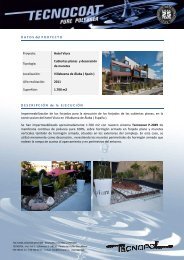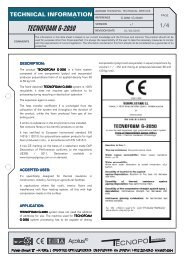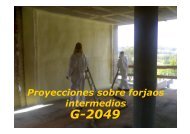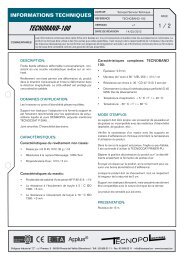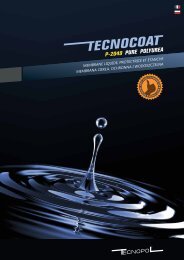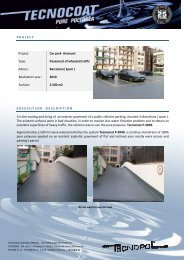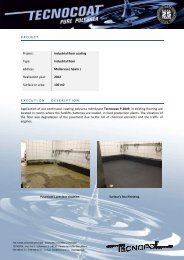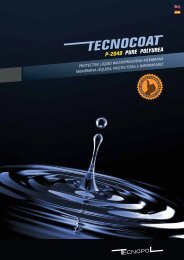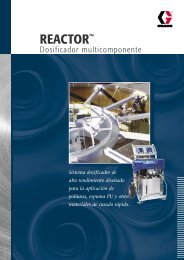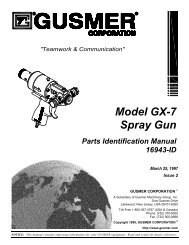TECNOFOAM I-2035
TECNOFOAM I-2035 - Tecnopol
TECNOFOAM I-2035 - Tecnopol
- No tags were found...
Create successful ePaper yourself
Turn your PDF publications into a flip-book with our unique Google optimized e-Paper software.
TECHNICAL INFORMATION<br />
AUTHOR<br />
REFERENCE<br />
Tecnopol Technical Service<br />
I-<strong>2035</strong> + G-2049.I<br />
PAGE<br />
<strong>TECNOFOAM</strong> I-<strong>2035</strong><br />
VERSION<br />
REVISION DATE<br />
v.3<br />
25/04/2013<br />
1 / 2<br />
COMMENTS<br />
The information in this data sheet is based on our current knowledge and the EU laws and national. The product should not be<br />
used for purposes other than those specified. It is always the responsibility of the user to take the necessary measures to comply<br />
with the requirements of current legislation. The information contained in this form should not be considered as a guarantee of its<br />
properties.<br />
Use’s indications:<br />
The product <strong>TECNOFOAM</strong> I-<strong>2035</strong> is a system composed of<br />
two components (polyol and isocyanate) produces polyurethane<br />
foam of an applied density from 40 to 47 kg/m3 ,is<br />
suitable for injection isolation application as on ducts , tubing,<br />
colds stores and rooms .<br />
It is free of substances harmful to the ozone layer and gases<br />
that promote the greenhouse effect (no contains HFCs,<br />
HCFCs, VOCs, etc ...).<br />
APPLICATION’S CONDITION:<br />
<strong>TECNOFOAM</strong> I-<strong>2035</strong> system do not need the addition of<br />
additives for use. The machine used for <strong>TECNOFOAM</strong><br />
I-<strong>2035</strong> system processing has to be capable of dosing components<br />
(polyol and isocyanate) in equal proportions by volume<br />
(+ / - 2%) and mixing at pressures between 60 and<br />
120 kg/cm2. The temperature of the machine, heaters and<br />
hoses should be set between 25 and 60 °C depending on<br />
environmental conditions, to obtain an optimal mix.<br />
In addition of changing ostensibly product performance,<br />
weather conditions, has influence on the quality of the foam<br />
in the spraying works. Therefore it is important that the<br />
temperature and the substrate surface, has to be between<br />
5 ºC and 40 °C, otherwise there may be areas with poor<br />
compliance, or dimensional changes more than expected.<br />
The substrate must be clean and dry and the humidity<br />
should be below 80%, because a high humidity can cause<br />
density alterations of the final product, and less adhesion to<br />
the substrate. Wind speed during the application must not<br />
exceed 30 km / h to avoid high consumption of materials;<br />
the irregular surface spraying could train particles that can<br />
cause serious problems of dirt surrounding the job place.<br />
During favorable environmental conditions, the adhesion<br />
of the foam, on the commonly used substrate, is excellent,<br />
provided they are clean, dry and free of rust. In all cases,<br />
before applying the foam is needed to perform an adhesion<br />
small test to ensure good fixation. In applications with high<br />
temperature gradients place a vapor barrier on the warm<br />
side of insulation system to prevent condensation. Smooth<br />
metal surfaces must be protected by an anti-corrosion<br />
primer before being covered with foam. On smooth surfaces<br />
without pores, galvanized steel, polypropylene, etc. ...<br />
should be primed for better adhesion and union of insulation<br />
system.<br />
STORAGE REQUIREMENTS:<br />
Storage temperature should be between 10 and 25°C.<br />
Containers (full or empty) should not be exposed to direct<br />
sunlight or heat sources such as stoves, radiators, etc. ...<br />
because they can generate pressure inside ,and will be dangerous<br />
its handling or manipulation . The components are<br />
moisture sensitive, must always be kept in airtight containers<br />
and be protected against the ingress of moisture at all<br />
times to avoid disruptions in the final product or rendered<br />
useless for treatment.<br />
EXPIRY:<br />
Polyol and isocyanate components have an optimal time established<br />
for use in which retain their physical and chemical<br />
properties favorable for further processing and obtaining<br />
foam which has all its properties. Once this period is ended,<br />
it appears a possible destabilization and gradual degradation<br />
of all chemical and physical characteristics of the final<br />
product will be more pronounced as time elapsed. In proper<br />
storage conditions and in original packaging, the optimal<br />
period for consumption is 3 months for polyol and 6 months<br />
for isocyanate from manufacture’s time.<br />
EXPOSURE CONTROLS AND PERSONAL<br />
PROTECTION DURING MANUPILATION:<br />
Request our safety record
TECHNICAL INFORMATION<br />
AUTHOR<br />
REFERENCE<br />
Tecnopol Technical Service<br />
I-<strong>2035</strong> + G-2049.I<br />
PAGE<br />
<strong>TECNOFOAM</strong> I-<strong>2035</strong><br />
VERSION<br />
REVISION DATE<br />
v.3<br />
25/04/2013<br />
2 / 2<br />
COMMENTS<br />
The information in this data sheet is based on our current knowledge and the EU laws and national. The product should not be<br />
used for purposes other than those specified. It is always the responsibility of the user to take the necessary measures to comply<br />
with the requirements of current legislation. The information contained in this form should not be considered as a guarantee of its<br />
properties.<br />
PROPERTIES OF APPLIED FOAM AND COMPONENTS:<br />
MIX RATIO In Volume by Weight<br />
Polyol 100 100<br />
Isocyanate 100 105<br />
COMPONENT FEATURES “polyol”<br />
Indice de hidroxilo 220 – 260 mg KOH (UNE-53.985-1)<br />
Contenido en agua 2,0 – 2,5 % (ISO-14.897)<br />
COMPONENT FEATURES “ISOCYANATE”<br />
NCO Content 30 – 32 % (UNE-92.120-1)<br />
REACTIVITY (*)<br />
Cream time 25 +/-3 seconds (UNE-92.120-1)<br />
Fiber time 90 +/-10 seconds (UNE-92.120-1)<br />
Contact time 170 +/-15 seconds (UNE-92.120-1)<br />
Free density glass 38 - 42 grams / liter (UNE-92.120-1)<br />
APPLIED FOAM PROPERTIES (*)<br />
Density applied 40 - 47 grams / liter (UNE EN 1602)<br />
Thermal conductivity 0.022 ± 0.001 W / m · K (UNE-EN 12.667)<br />
Reaction to fire Class E (EUROCLASSES) (UNE EN 13.501-1)<br />
Water absorption (**) < 5% by volume M. INT.<br />
(*) Under laboratory conditions, according to the UNE-92120-1<br />
(**) The water absorption by the rigid polyurethane foam is produced as a function of environmental conditions and can<br />
take place by wetting or by diffusion and condensation of steam. Is influenced primarily by the density and dimensions.<br />
In any case, the moisture content in practice, not exceed 5% by volume.



